

| Is there new hope for Clipstone Old Quarter's Glow Worms? |
| ... |
| After years of neglect, leading to a quite remarkable deterioration of some wonderful grass heathland habitat, there appears to be hope on the horizon for the possible restoration of Clipstone Old Quarter. Clipstone Old Quarter forms part of the Birklands West and Ollerton Corner Site of Special Scientific Interest (SSSI) which is one of two SSSI's making up the Sherwood Forest National Nature Reserve (NNR). | ||
| ... | ||
| Regular visitors to
www.eakringbirds.com will be
aware of our association with Glow Worms, in particular with our
former study colony at Clipstone Old Quarter. It's an association
that is well known across the UK and one which is (or at least was)
enormously well respected among those with a similar interest in
Glow Worms. But ultimately it was an association which became tainted, as opinions divided, egos clashed and in particular, that those monitoring some Glow Worm related groups on social media, became so controlling and authoritarian that it made many feel that they had no option other than to leave. We were among those who felt compelled to leave. But leaving the ever increasing aggressiveness of social media was never a problem, as we were forced through ill health to ease down and ultimately cease regular surveying of Glow Worms at Clipstone Old Quarter. It was an association which began back in 2008, following a chance encounter with a wandering Glow Worm larva and the rest as they say .... is history. |
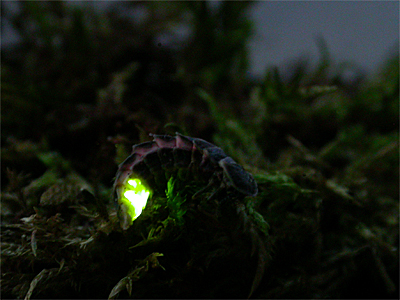 |
|
| .... | ||
| That chance encounter led to well over 1,000 site surveys, never missing a night from before the first female emerged, till around a week after the last female was recorded glowing wherever it was on site. It was a mammoth effort, incredibly worthwhile and which eventually led to new information regarding the biology and habits of this wonderous and quite magical beetle. Surveying finally stopped in 2017, after ill health finally forced us to reduce our survey area to a more practical and managable level. It ultimately turned out that 2017 was a short season - not believed to be shorter as a direct consequence of surveying less of the site than normal, but more likely induced via several other factors once comparisons with previous years data had been made. This included a possible natural decrease in the population (especially of females) in some survey sections. |
| ... |
|
Fig 08 shows the maximum
recorded percentages of 'one night' females at Clipstone
Old Quarter between 2010 and 2017. The total number of
males (nM) recorded during each season is given in column
two, with column three showing the date range per 50
females involved and column four giving the peak
percentage of females mated on the first night. The high number of males was the subject of many conversations between Glow Worm enthusiasts on social media. But the percentage of 'one night' females eventually proved to be similar to three other seasons, despite us thinking to the contrary at the time. In the end, what had initially seemed to be very high numbers of males at the time, wasn't really that unusual based on our own records. |
|||||||||||||||||||||||||||||||||||||||||
| ... | ||||||||||||||||||||||||||||||||||||||||||
| But it was other factors such as habitat and larval loss resulting from damaging commercial forestry operations that probably had the greatest effect. These operations were neccessary on two accounts - one being that Pine is purely grown by Forestry England as a profitable crop at the end of the day and second, that the removal of Pines was required as part of Natural England's existing management plan to restore Sherwood Forest NNR's Pine plantations back to lowland heath. |
| .. |
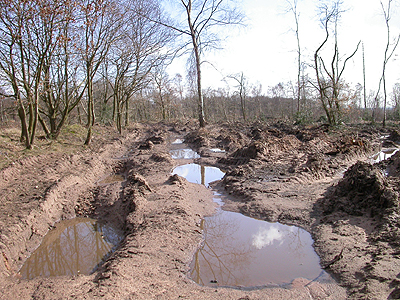 |
But the process of felling and extraction
takes a heavy toll on habitat, especially when operations are
carried out in wet weather.
The felling and removal of one particular Clipstone Old Quarter
plantation in 2014 proved disastrous and effectively left the area looking like the
Somme battlefield. It was no exaggeration, as the picture on the
left shows. Although the habitat lost along this area has since recovered to a
degree, Glow Worm numbers haven't. Over the years, damage has been considerable to some areas of Clipstone Old Quarter through one means or another and it takes several years before it becomes suitable again. Glow Worm numbers in the worst affected areas have yet to show any real signs of increasing again, even five years after. Increases in Glow Worm populations following large-scale losses are slow and if habitat remains unsuitable, or there is persistant disruption for a number of years, damage to Glow Worm populations in forested areas increases year on year. Eventually these populations weaken, become increasingly less viable and ever more isolated and eventually tend to die out. |
| ... | ||
| Its the site's larval populations that generally takes the brunt of forestry operations when the Autumn and Winter felling and extraction work is generally carried out. But Glow Worms are tenacious beetles and small numbers can withstand even the worst apocalyptic destruction for a time, although the damage to fragile populations is usually done by then and it takes many years for numbers to recover to anywhere remotely near previous levels. These small populations have proved difficult to find and our research has showed that these populations consist at best, of just a handful of females each year. It means that you can walk the forest for years and only locate these isolated populations after maybe four or five years. You just happen to strike lucky. | ||
|
Volunteer surveying on behalf of the Nottinghamshire Glow Worm
Survey (NGWS) has located females in previously unknown areas of the
Country Park and other forested areas adjacent to Clipstone Old
Quarter. But while these small populations might suggest the Glow
Worm is common, it has been found not to be the case. The map shows all the Glow Worm locations recorded in the general Sherwood Forest area of Nottinghamshire. The locations are based on existing records and those recieved by the Nottinghamshire Glow Worm Survey since 2012. The smaller dots refer to locations with very small populations or number of records, sometimes based on the sighting of just a single glowing female. The largest red dot is Clipstone Old Quarter, which is part of three Glow Worm population complexes in this part of Nottinghamshire, namely (from top to bottom) Clumber Park, Sherwood Forest NNR and Sherwood Pines. Glow Worms in the Harlow Wood area now seem solely restricted to Harlow Wood, but there are a handful of former Glow Worm sites located at nearby commercially forested sites. These have been well surveyed by NGWS surveyors but always produced negative results. The recovery of Glow Worm numbers in the worst affected areas of Clipstone Old Quarter, have yet to be recorded and the same applies to any of the other small, isolated Glow Worm populations also monitored in the Sherwood Forest NNR. But while forestry operations have contributed greatly to Glow Worm decline at Clipstone Old Quarter, its certainly not the only contributor. Sorry if you liked car rallying, but the ending of the Dukeries Car Rally stage through Sherwood Forest was largely down to us and several other parties, after putting the (then) Forestry Commission under pressure to stop hosting the rally. It was done for conservation purposes only and even now, still seems unbelievable that the event was ever allowed to go through a National Nature Reserve in June, especially considering that Natural England or the renamed Forestry England never insisted on any protection measures to the habitat from oil spills and fires as a result of crashes etc. Rather ironically, if you wanted to run a moth trap on Forestry England land, they would not issue you with a permit to trap without having a petrol spill kit! But we had good reason to get the rally stopped. The effects of the rally in June were great, regardless of whether it was bone dry or very wet. Either way, the vegetation on the forest track verges became covered in thick dust, sand and stones, or a chocolate-like mud, while other areas were trodden by the watching public. And then, following the rally each year, came the mechanical scraping and smoothing of the forest tracks, which saw the resulting stone spoil tipped on to the verges, disaster for many Glow Worms and other invertebrates. |
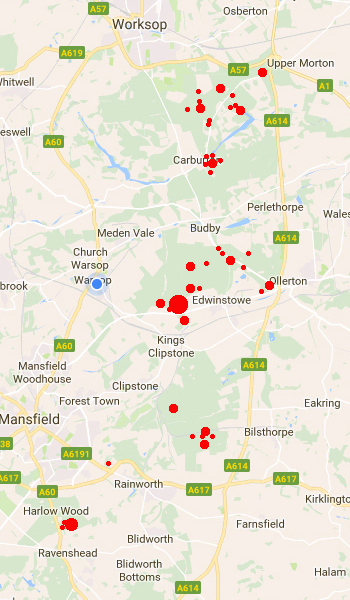 |
|
| ... | ||
| The Dukeries Rally was also proven to be responsible in the eradication of at least one Nightjar nest which in a way perhaps helped the cause. So at least we had other parties with the same view as ours, agreeing that a National Nature Reserve was not the place to hold an event of this kind, especially when considering it was detrimental to some of the species it was supposed to be giving protection to. It would have been fine for the event to have been held in Autumn or Winter and we'd have had no problem with that. |
| ... |
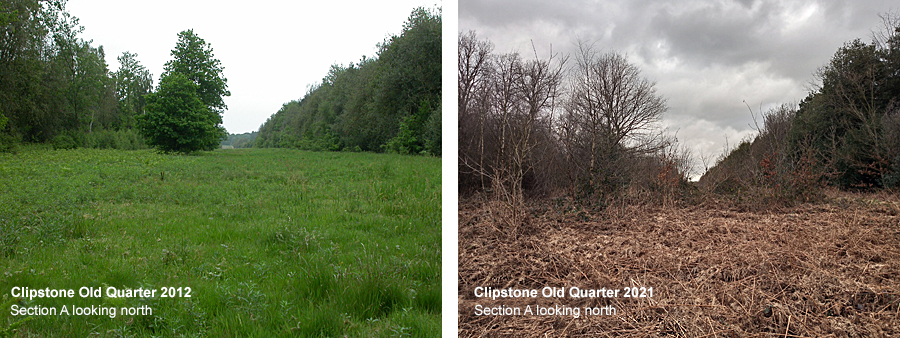 |
| ... |
| But one of the most worrying factors was the deteriorating conditions along the grass strip running alongside the Sustrans path. Increasing scrub encroachment along sections A, B and C, meant that it soon became impossible to survey those sections, as existing stands of Bracken and Bramble encroached further. But Birch and Oak scrub soon added to the increasing Bracken and Bramble problem and it was a problem that nobody addressed. Up until the Autumn and Winter of 2015/16, the grass strip was always cut once a year between September and March. |
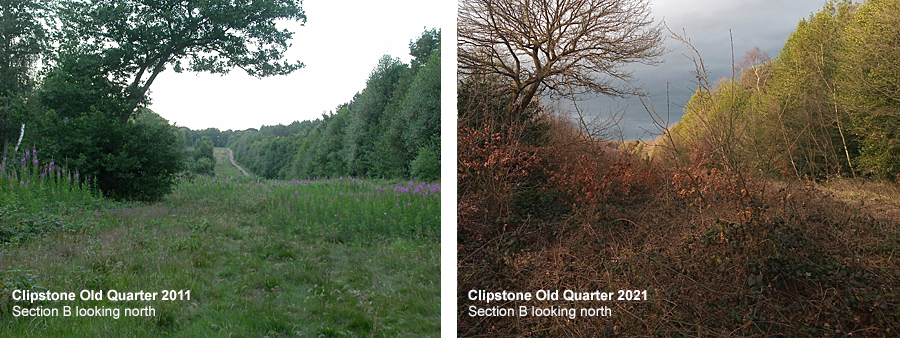 |
| This we had previously agreed as being suitable for Glow Worms, when we had a group walk and talk with the Forestry Commission's ecologist and other FC staff a number of years previously. The aim was to show those attending Glow Worms, to walk around Clipstone Old Quarter, talk about their ecology, habitat requirements and to discuss how the site could be better managed. They even helped us with the night's surveying and it all ended extremely positive. |
|
But after 2015,
the annual cutting of the grass strip running alongside the Sustrans
path stopped. Since 2008, it became known as sections A, B, C and D
of our survey route to Glow Worm enthusiasts across the UK and
Europe, who visited
www.eakringbirds.com for
regular updates and sightings. The well known and popular attraction of the website was how frequently it was updated. Having up to date results and survey counts on an almost daily basis (often updated immediately on arrival back home) ensured that people regularly kept visiting the website. It was also quite unique as being the only website to provide quality, reliable data and updated analysis on a daily basis. It made people keep coming back. Clipstone Old Quarter soon became nationally known for producing the first larva and first female Glow Worm in the UK on numerous occasions. Indeed, it is known that some never began visiting their Glow Worm sites, until the first had appeared here. This happened on a number of years between 2009 and 2020 and was something we put down to our habit of beginning surveys a couple of weeks before the we thought the first female would occur. |
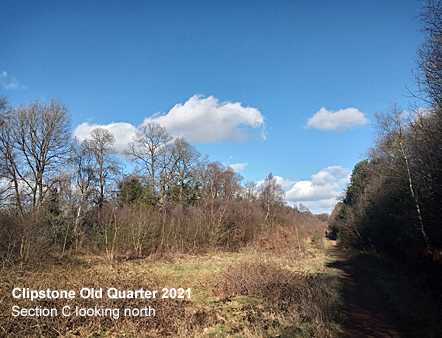 |
|
|
Cutting had always been done by tractor pulled gang mower, either in
early Spring or late Autumn and to a minimum height of four inches.
The last mowing of sections of A, B, C and D, took place sometime
between September 2015 and March 2016 and it has remained untouched
since. This has allowed the spread of extremely invasive plants such
as Bramble, Willowherb and Bracken to encroach across all grass
sections. Oak and Birch scrub soon added to the encroachment
problem, which increases as you near the A6075 Peafield Lane. The speed at which the grass/heath habitat has deteriorated has really been astonishing, so the accompanying 'then and now' photographs will give the reader some indication of both the mouting problem and short timescale. But how its been allowed to become such a problem is something of a mystery. |
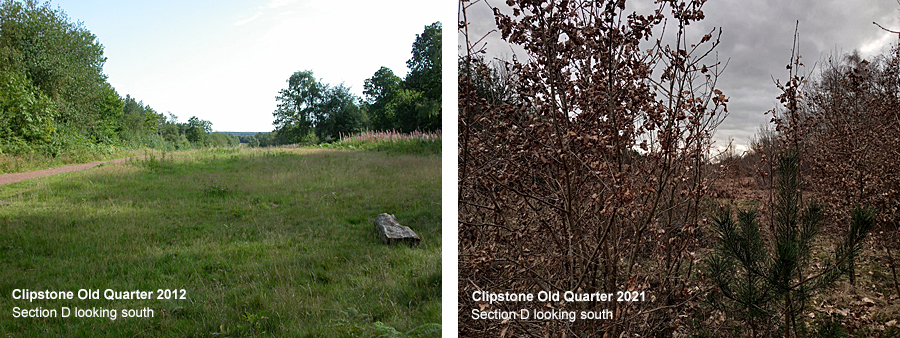 |
|
Back in our 2017 Glow Worm summary, it was mentioned that 'section D
was becoming less suitable for
Glow Worms and is now in need of some light management.
This year, it seemed increasingly evident that females
were becoming more confined to the centre of the grass
strip in Section D, as scrub and invasive weeds encroach
from both sides'. Well looking at the grass sections now, such a
comment shows just how right our opinion was at the time. Scrub Oak
and Birch growth, alongside Bramble and Bracken etc, have now become
such a problem that it is now totally impossible to walk the grass
strip anymore. The difference is unbelievably sad, in view of what
Clipstone Old Quarter once was. But I have no idea if it was planned to miss a few years cutting as part of some deliberate management decision, but I think not and so somehow the site has been left and the grass strip has deteriorated alarmingly. Vegetative encroachment has assisted the decrease in the number of females being found along the path edges in this section. We had noted this particular aspect of population shift and decline in previous years. So female larvae searching for a pupation site with an open aspect (ideal for glowing and attracting males from) now either have to wander further, or are forced to pupate in a less suitable (heavily vegetated) site than they did a few years ago. |
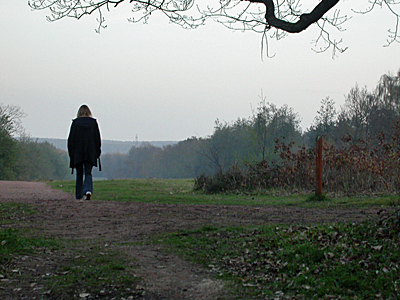 |
Whichever way it's looked at,
Clipstone Old Quarter has been neglected by those responsible for
managing the Sherwood Forest NNR. Personally, I think that all the
effort and available money has been concentrated towards the
Sherwood Forest Country Park and Budby South Forest. Both these
sites now come under the management of the RSPB, although Natural
England presumably still have final say in the day to day management
of both these areas and the rest of the NNR. Whether the lack of yearly cutting has evolved as the result of confusion between the landowners, Natural England or Forestry England, as to who's responsibilty the cutting actually is I have no idea. Despite Clipstone Old Quarter forming part of the Birklands West and Ollerton Corner SSSI, the only work undertaken has been the removal of the last of the Pines a few years ago, the removal of the compartment fencing and (in 2021) the wooden compartment gates, the yearly cutting of the forest track verges, Bracken control in the clear fell areas, haloing around some of the ancient Oaks, but seemingly nothing to help the site's Glow Worm population. |
|
|
Now we've always been more than aware that Glow Worms are afforded
no protection status through being especially rare or uncommon,
but our own years of continuous surveys, in addition to those sent
in to the Nottinghamshire Glow Worm Survey, all show that the
Nottinghamshire population has declined and still continues to do
so. No matter which particular 'authority' you listen to, those with an interest and intimate knowledge of the county's Glow Worms, agree that there is a very valid concern for the long term survival of the Glow Worm in Nottinghamshire. Fellow Glow Worm enthusiast and local expert Martin Dale, Dilys and myself, tried for years to get some official recognition that there is a decline in UK Glow Worm populations, as well as in Nottinghamshire. But it seems that as long as the odd Glow Worm keeps turning up in gardens across southern UK counties, then there is blanket refusal to accept the declines noted from a number of counties, even those declines recorded by a number of other experts. It is easy for those who sit at home and dismiss our claims as fanciful, which makes it all incredibly frustrating. It seems that there is reluctance to accept, or indeed even publish any news or findings with a negative slant. But at last there seems to be some hope and following a chance meeting with representatives from the Sherwood Forest Trust and Thoresby Estate recently, it was determined that something is actually being done and probably beginning late in 2021. There obviously needs to be a number of meetings and consultations to determine a plan of action to take and based on the opinions of the various interested/involved parties. I have been asked to be involved and I have initially accepted the offer. But make no mistake, the problem of returning Clipstone Old Qaurter to something like its best is a large one and one which will require much effort from all parties to be make it successful. It will be drastic work, as the grass strip has dreadfully deteriorated, the Sustrans path needs reinstating to previous its width and needs levelling as there is increasing erosion from rainfall and mechanical erosion from footfall and cycle use. The work will affect Glow Worms, but it has to be done now and thankfully, it seems that the wheels are in motion ... at last. Let's hope the Glow Worm is in for a better future here. |
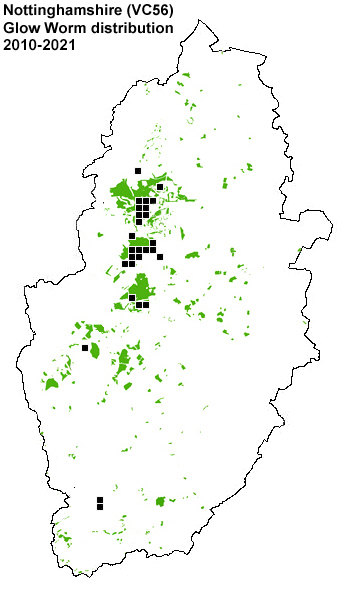 |